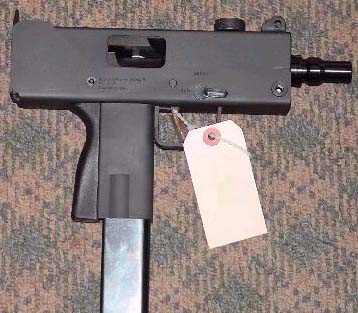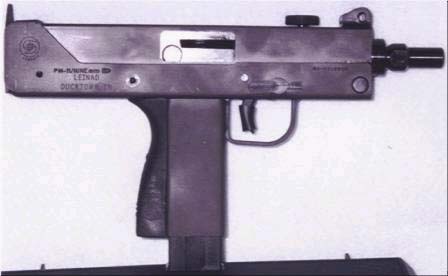 The Mac (Mac-10, Mac-11,
Mac-12)
The Mac (Mac-10, Mac-11,
Mac-12)
Model
|
Length overall |
Barrel Length |
Weight |
Caliber |
Action Type |
Magazine Capacity |
Mac-10
|
10.5
|
|
6.25
|
45
|
semi auto blowback
|
10 to 30
|
Mac-11
|
10.5
|
|
6.25
|
9mm
|
semi auto blowback
|
10 to 32
|
Mac-12
|
8.75
|
|
3.5
|
380
|
semi auto blowback
|
10 to 32
|
The firearms version of junk food.
When I was very young, back in the early seventies,
the Ingram MAC-10 made a lasting impression on me. My first exposure to
it was in the movie The Killer Elite. I marveled at the small size, and amazing
cyclic rate (1100-1600 rpm) of the gun. It was not shown clearly, and I
had no idea what it was, thinking that it might be some variation of the
Uzi. I saw the gun once again, on a television rerun of the John Wayne movie
McQ. The initial release of McQ, some years before I saw it, was actually
the first public showing, or at any rate the first movie showing, of the
MAC (Military Armament Company) Model 10, the MAC-10. The gun began to show
up in magazines, SOF in particular, and I was finally able to learn the facts
about this remarkable little pistol/smg. Latter on, when the little gun
made an appearance in the Chuck Norris movie, Invasion USA, I was quite well
aquanted with the MAC.
The Ingram MAC-10 was (and is) just about the most
compact assault weapon made. It is an intersting hybred of pistol, and
carbine. Though it looks like an overgrown pistol on steroids, the MAC
has a true bolt, like a rifle, and does not use a pistol style slide. The
origonal model was chambered for .45 ACP, but variants soon appeared in
9mm. Latter on, a smaller version, the MAC-11, was made in 380 and eventually
in 9mm. These were Viet Nam era guns, designed for use with a silencer. The
guns came standard with a barrel threaded for it's use, even the semi auto
civilian version.
The Ingram was essentially the sixties/seventies
answer to the same requirements which spawned the STEN gun in the forties. It was small, simple, cheap to make, rugged, and (unlike the STEN)
very reliable. It was designed by Gordon Ingram around 1970. The exact
date of initial production is rather cloudy, given the covert nature of
the early users. These guns are made using simple stamping, welding, and
pinning manufacturing techniques. The small size is due to the use of a
telescoping bolt, which rides over part of the barrel. This is a modification,
and further development of the bolt design of the Uzi, which is itself an
improvement of an earlier Czech design.
It was small, simple, cheap to make, rugged, and (unlike the STEN)
very reliable. It was designed by Gordon Ingram around 1970. The exact
date of initial production is rather cloudy, given the covert nature of
the early users. These guns are made using simple stamping, welding, and
pinning manufacturing techniques. The small size is due to the use of a
telescoping bolt, which rides over part of the barrel. This is a modification,
and further development of the bolt design of the Uzi, which is itself an
improvement of an earlier Czech design.
First of all, I must confess that, in their semi
auto civilian legal form, these are just about the dumbest firearms you
can own. As much as the design of the MAC-10 smg fascinated me, I never
felt the desire to buy the civilian, semi auto, version. In 1934, roosevelt
forced through a series of unconstitutional laws known as the NFA of 1934.
One of the provisions of these acts was to prohibit manufacture of short
barreled rifles, or of stocked pistols. These acts also taxed and restricted
full auto firearms. Because of this, civilian MACs must neccesarily
differ somewhat from the standard military models, and come in pistol and
carbine versions. The pistol version, is essentially a standard, semi auto
MAC with the wire stock removed. The carbine is stocked, and has the legally
required 16" barrel. In these "civilian safe" forms, the wonderfull MAC,
becomes a rather unappealing and very compromised firearm.
As a standard pistol, the MAC is far too bulky, and
heavy. As a carbine, the gun is far too inaccurate. Slapping a 16" barrel
on a MAC hardly quallifies it as a long range weapon. The MAC was never
designed to fill either of these roles, and it is quite unsuited to them.
About the only good thing you can say about the MAC pistol, and carbine,
is that at least they are not the TEC-9. Early civilian models fired from
an open bolt, in the same manner as the military smg. Latter models used
a closed bolt. In both cases, the cocking handle is located on top of the
reciever, as in the Thompson M1928.
The ban of 1994 made these guns even less desirable
by greatly increasing their prices, and by limiting the supply of high capacity
magazines, and requiring the pistols to be shorn of their threaded barrels.
This lessened the appeal of a weapon which already held marginal appeal
for most shooters. The great increase in price made these guns desireable
only to die hard collectors, and ironically, to criminals. Still, nothing
lasts forever, and the odious clinton gun bill has expired, at least in
most places. Because of this, prices have now dropped drasticly. It also
seems likely that new manufacture magazines will again be available to civilians,
and that the little guns can regain their threaded barrels. They will still
not be permitted the addition of military wire stocks, since this is prohibited
by the 1934 ban, which will remain in effect. New production Ingrams are
once again available for under $300, making them cheaper than most regular
pistols.
- cheap to make
- military type weapon available in large numbers
- not really in demand
Mac-10
The origonal Ingram model, whcih was chambered for the 45 A.C.P., and
issued to Special Forces for a variety of covert and guard duties. In it's
origonal form, this was a select fire arm, and came with a folding wire stock.
Mac-11
A smaller version of the MAC, which came chambered in 9mm, and 380 calibers.
This gun was the same length, but did not have quite so high a reciever as
the origonal MAC 10
Mac-12
 The Mac (Mac-10, Mac-11,
Mac-12)
The Mac (Mac-10, Mac-11,
Mac-12)
 The Mac (Mac-10, Mac-11,
Mac-12)
The Mac (Mac-10, Mac-11,
Mac-12)
 It was small, simple, cheap to make, rugged, and (unlike the STEN)
very reliable. It was designed by Gordon Ingram around 1970. The exact
date of initial production is rather cloudy, given the covert nature of
the early users. These guns are made using simple stamping, welding, and
pinning manufacturing techniques. The small size is due to the use of a
telescoping bolt, which rides over part of the barrel. This is a modification,
and further development of the bolt design of the Uzi, which is itself an
improvement of an earlier Czech design.
It was small, simple, cheap to make, rugged, and (unlike the STEN)
very reliable. It was designed by Gordon Ingram around 1970. The exact
date of initial production is rather cloudy, given the covert nature of
the early users. These guns are made using simple stamping, welding, and
pinning manufacturing techniques. The small size is due to the use of a
telescoping bolt, which rides over part of the barrel. This is a modification,
and further development of the bolt design of the Uzi, which is itself an
improvement of an earlier Czech design.